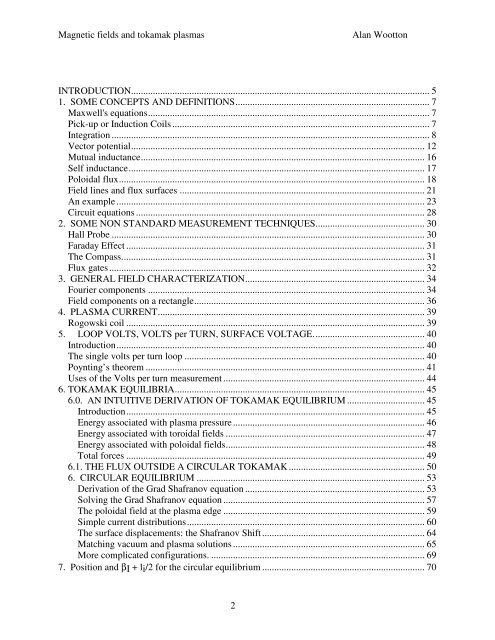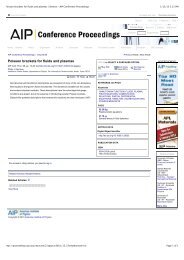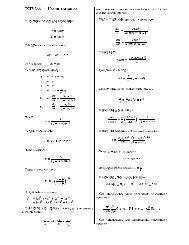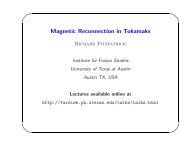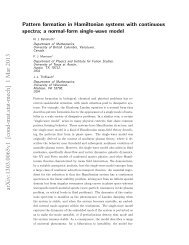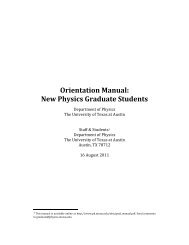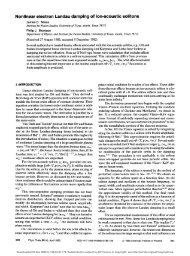Magnetic Fields and Magnetic Diagnostics for Tokamak Plasmas
Magnetic Fields and Magnetic Diagnostics for Tokamak Plasmas
Magnetic Fields and Magnetic Diagnostics for Tokamak Plasmas
You also want an ePaper? Increase the reach of your titles
YUMPU automatically turns print PDFs into web optimized ePapers that Google loves.
<strong>Magnetic</strong> fields <strong>and</strong> tokamak plasmas<br />
Alan Wootton<br />
INTRODUCTION........................................................................................................................... 5<br />
1. SOME CONCEPTS AND DEFINITIONS................................................................................ 7<br />
Maxwell's equations.................................................................................................................... 7<br />
Pick-up or Induction Coils .......................................................................................................... 7<br />
Integration ................................................................................................................................... 8<br />
Vector potential......................................................................................................................... 12<br />
Mutual inductance..................................................................................................................... 16<br />
Self inductance.......................................................................................................................... 17<br />
Poloidal flux.............................................................................................................................. 18<br />
Field lines <strong>and</strong> flux surfaces ..................................................................................................... 21<br />
An example ............................................................................................................................... 23<br />
Circuit equations ....................................................................................................................... 28<br />
2. SOME NON STANDARD MEASUREMENT TECHNIQUES............................................. 30<br />
Hall Probe ................................................................................................................................. 30<br />
Faraday Effect ........................................................................................................................... 31<br />
The Compass............................................................................................................................. 31<br />
Flux gates.................................................................................................................................. 32<br />
3. GENERAL FIELD CHARACTERIZATION.......................................................................... 34<br />
Fourier components .................................................................................................................. 34<br />
Field components on a rectangle............................................................................................... 36<br />
4. PLASMA CURRENT.............................................................................................................. 39<br />
Rogowski coil ........................................................................................................................... 39<br />
5. LOOP VOLTS, VOLTS per TURN, SURFACE VOLTAGE.............................................. 40<br />
Introduction............................................................................................................................... 40<br />
The single volts per turn loop ................................................................................................... 40<br />
Poynting’s theorem ................................................................................................................... 41<br />
Uses of the Volts per turn measurement ................................................................................... 44<br />
6. TOKAMAK EQUILIBRIA....................................................................................................... 45<br />
6.0. AN INTUITIVE DERIVATION OF TOKAMAK EQUILIBRIUM ................................ 45<br />
Introduction........................................................................................................................... 45<br />
Energy associated with plasma pressure ............................................................................... 46<br />
Energy associated with toroidal fields .................................................................................. 47<br />
Energy associated with poloidal fields.................................................................................. 48<br />
Total <strong>for</strong>ces ........................................................................................................................... 49<br />
6.1. THE FLUX OUTSIDE A CIRCULAR TOKAMAK ........................................................ 50<br />
6. CIRCULAR EQUILIBRIUM .............................................................................................. 53<br />
Derivation of the Grad Shafranov equation .......................................................................... 53<br />
Solving the Grad Shafranov equation ................................................................................... 57<br />
The poloidal field at the plasma edge ................................................................................... 59<br />
Simple current distributions.................................................................................................. 60<br />
The surface displacements: the Shafranov Shift................................................................... 64<br />
Matching vacuum <strong>and</strong> plasma solutions ............................................................................... 65<br />
More complicated configurations. ........................................................................................ 69<br />
7. Position <strong>and</strong> βI + li/2 <strong>for</strong> the circular equilibrium ................................................................... 70<br />
2


